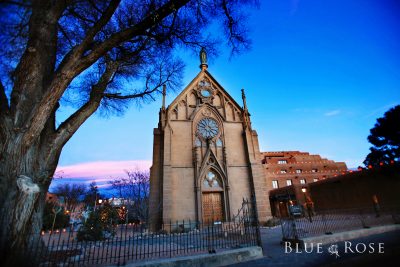About Santa Fe
 We are just beginning our winter season in Santa Fe, which means that Ski Santa Fe is beckoning. Fireplaces in cozy downtown restaurants (Del Charro for rowdy, Rio Chama for less rowdy, SantaCafe for quiet) are awaiting. The best thing about Santa Fe in winter is that the crowds are thinner while the mountains are stunning. You can live like a local instead of having to manage your stroll through the more dense summer shoppers and tourists.
We are just beginning our winter season in Santa Fe, which means that Ski Santa Fe is beckoning. Fireplaces in cozy downtown restaurants (Del Charro for rowdy, Rio Chama for less rowdy, SantaCafe for quiet) are awaiting. The best thing about Santa Fe in winter is that the crowds are thinner while the mountains are stunning. You can live like a local instead of having to manage your stroll through the more dense summer shoppers and tourists.
If you’re visiting, take a minute to also stroll through the many pages on this website – my blog has great ideas for dinner, Santa Fe Style shopping, sightseeing, or world-famous art and culture, while the properties shown are all available for a tour by you. It is a wonderful resource for all things Santa Fe.
Santa Fe has been named “the best of” by so many organizations and news outlets that it’s difficult to list them all. In 2012, Santa Fe was listed among the 10 best places to retire in the U.S. by CBS Money Watch and U.S. News. With so many museums, galleries, festivals, arts & music organizations, and the amazing landscape, it is easy to see why.
Santa Fe has also been named the #1 “World’s Best Place to Photograph” for 2015; one of the top “7 places for Singles to Visit”; “America’s 7th Best Food City” by Conde Nast 2014; one of National Geographic’s top ten high altitude cities, and on and on and on. Once you visit, you understand all the accolades. There really is no place quite like Santa Fe.
Santa Fe History
Known settlements in Santa Fe date to 900 AD. A few Pueblo villages emerged after 1050. Ogapoge was a village built around today’s Plaza and extended for about half a mile to the south and west. The Santa Fe River provided water to people living there.
13 years before the founding of Plymouth Colony, in 1607, there was a small Spanish settlement of Santa Fe. However, it wasn’t until 1610 that the Don Pedro de Peralta established Santa Fe as the capital of the province, calling it La Villa Real de la Santa Fe de San Francisco de Asís (The Royal Town of the Holy Faith of Saint Francis of Assisi.) This makes Santa Fe the oldest capital city in the United States and the oldest city in New Mexico.
The late 17th century witnessed the Pueblo Revolt, also known as Popé’s Rebellion. This uprising pitted most of the Pueblo Indians against the Spanish colonizers, killing 400 Spanish and driving the remaining 2,000 settlers out of the province.
Twelve years later the Spanish, led by Don Diego de Vargas, returned and were able to peacefully reoccupy New Mexico. Until 1810 (the Mexican War of Independence), Santa Fe remained Spain’s provincial seat. The Constitution of 1824 formalized the city’s status as the capital of the Mexican territory.
The mid-19th century saw a war between the US and Mexico. In 1846, Brigadier General Stephen W. Kearny led the main body of his Army of the West of some 1,700 soldiers into the city to claim it and the whole New Mexico Territory for the United States. By 1848 the U.S. officially gained New Mexico through the Treaty of Guadalupe Hidalgo.
The Saint Francis Cathedral (now The Cathedral Basilica of Saint Francis of Assisi) was built by Archbishop Jean Baptiste Lamy between 1869 and 1886 on the site of an older adobe church, La Parroquia. Designed in the Romanesque Revival style, the cathedral features characteristic round arches separated by Corinthian columns and truncated square towers. Imported from Clermont-Ferrand in France, it also features a large rose window in front and the Twelve Apostles in the lateral nave windows. Originally planned to be topped with 160 ft steeples, the towers were never built due to lack of funds.
During the Civil War, the Confederate flag of General Henry Sibley flew over Santa Fe for a few days until he was forced to withdraw by Union troops, who destroyed his logistical trains following the battle of Glorietta Pass.
Despite the Santa Fe’s prominence as a city and as the last stop on the famous Santa Fe Trail, the Atchison, Topeka and Santa Fe Railway chose to bypass the town for practical reasons in the 1870s. This led to a slow economic decline until Santa Fe’s art and archeology resources were ‘discovered’ in the early 20th century. As Santa Fe’s fame as a rich cultural region led to the founding of the annual Santa Fe Indian Market and many other festivals that are celebrated to this day.
New Mexico became the United States of America’s 47th state in 1912, with Santa Fe as its capital.
For over 100 years, artists and writers have visited Santa Fe, only to fall in love with the city and stay. Georgia O’Keeffe, who lived for a time in Santa Fe before moving 50 mi away to Abiquiu, is honored by the famous Georgia O’Keeffe Museum. The New Mexico Museum of Art also owns several of her works.
Just east of the Plaza is Canyon Road, a major destination for international collectors and tourists. Locals love a stroll past the beautiful old buildings and galleries lining the street featuring a wide array of contemporary, Southwestern, indigenous American, and experimental art, including sculpture.

Copyright© 2026 Bunny Terry, Real Broker
Licensed in New Mexico.
All information provided is deemed reliable but is not guaranteed and should be independently verified. Properties subject to prior sale or rental.
Design and Hosting by Santa Fe Web Design
